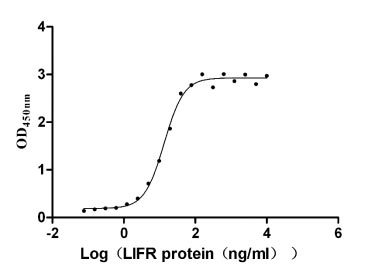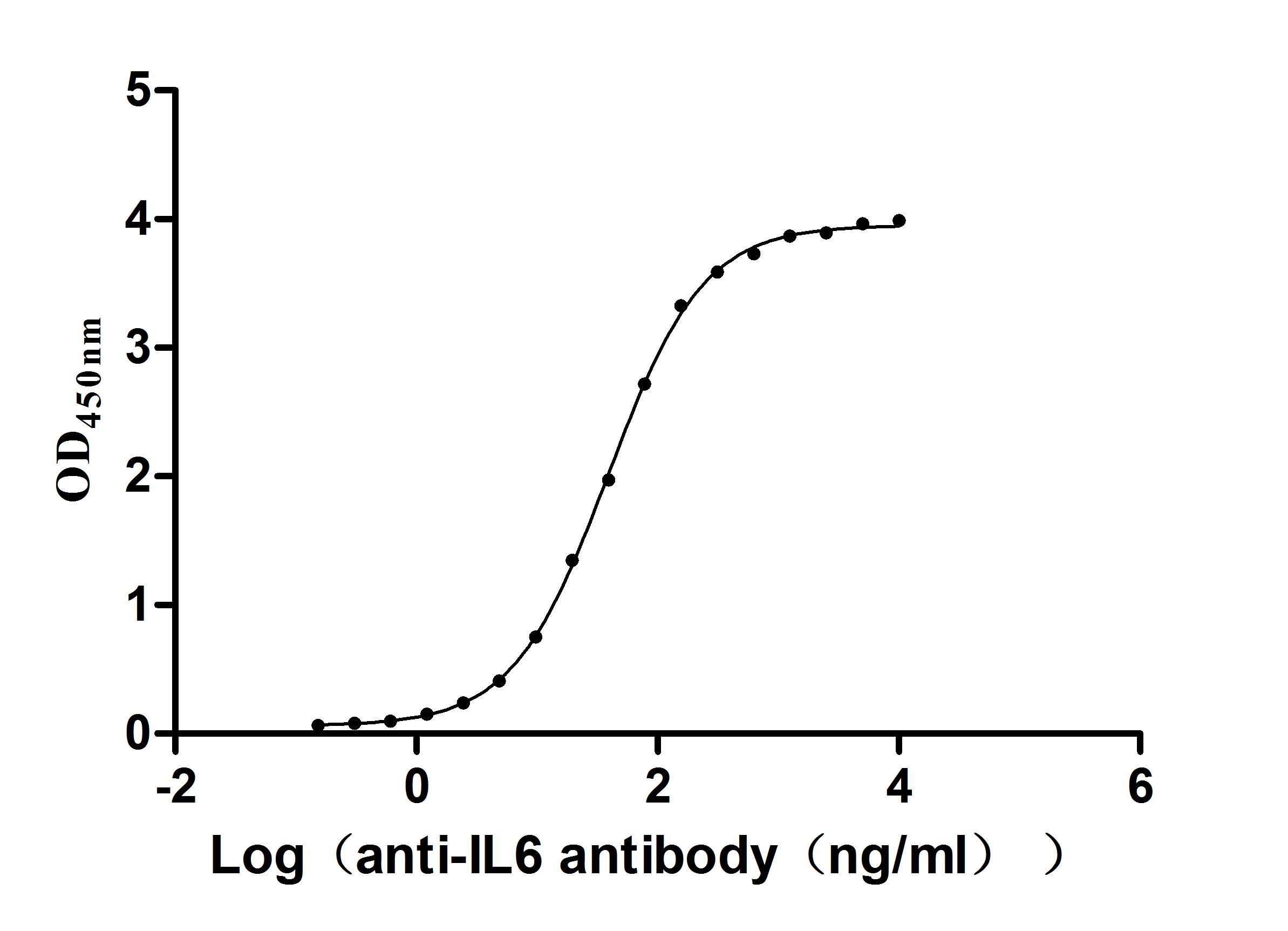Recombinant Human Complement C1q subcomponent subunit A (C1QA)
-
货号:CSB-YP003637HU
-
规格:
-
来源:Yeast
-
其他:
-
货号:CSB-EP003637HU-B
-
规格:
-
来源:E.coli
-
共轭:Avi-tag Biotinylated
E. coli biotin ligase (BirA) is highly specific in covalently attaching biotin to the 15 amino acid AviTag peptide. This recombinant protein was biotinylated in vivo by AviTag-BirA technology, which method is BriA catalyzes amide linkage between the biotin and the specific lysine of the AviTag.
-
其他:
-
货号:CSB-MP003637HU
-
规格:
-
来源:Mammalian cell
-
其他:
产品详情
-
纯度:>85% (SDS-PAGE)
-
基因名:
-
Uniprot No.:
-
别名:C1qa; C1QA_HUMAN; Complement C1q subcomponent subunit A; Complement component 1 q subcomponent A chain; Complement component 1 q subcomponent alpha polypeptide; Complement component C1q A chain
-
种属:Homo sapiens (Human)
-
蛋白长度:Full Length of Mature Protein
-
表达区域:23-245
-
氨基酸序列EDLCRAPD GKKGEAGRPG RRGRPGLKGE QGEPGAPGIR TGIQGLKGDQ GEPGPSGNPG KVGYPGPSGP LGARGIPGIK GTKGSPGNIK DQPRPAFSAI RRNPPMGGNV VIFDTVITNQ EEPYQNHSGR FVCTVPGYYY FTFQVLSQWE ICLSIVSSSR GQVRRSLGFC DTTNKGLFQV VSGGMVLQLQ QGDQVWVEKD PKKGHIYQGS EADSVFSGFL IFPSA
-
蛋白标签:Tag type will be determined during the manufacturing process.
The tag type will be determined during production process. If you have specified tag type, please tell us and we will develop the specified tag preferentially. -
产品提供形式:Lyophilized powder
Note: We will preferentially ship the format that we have in stock, however, if you have any special requirement for the format, please remark your requirement when placing the order, we will prepare according to your demand. -
复溶:We recommend that this vial be briefly centrifuged prior to opening to bring the contents to the bottom. Please reconstitute protein in deionized sterile water to a concentration of 0.1-1.0 mg/mL.We recommend to add 5-50% of glycerol (final concentration) and aliquot for long-term storage at -20℃/-80℃. Our default final concentration of glycerol is 50%. Customers could use it as reference.
-
储存条件:Store at -20°C/-80°C upon receipt, aliquoting is necessary for mutiple use. Avoid repeated freeze-thaw cycles.
-
保质期:The shelf life is related to many factors, storage state, buffer ingredients, storage temperature and the stability of the protein itself.
Generally, the shelf life of liquid form is 6 months at -20°C/-80°C. The shelf life of lyophilized form is 12 months at -20°C/-80°C. -
货期:Delivery time may differ from different purchasing way or location, please kindly consult your local distributors for specific delivery time.Note: All of our proteins are default shipped with normal blue ice packs, if you request to ship with dry ice, please communicate with us in advance and extra fees will be charged.
-
注意事项:Repeated freezing and thawing is not recommended. Store working aliquots at 4°C for up to one week.
-
Datasheet :Please contact us to get it.
相关产品
靶点详情
-
功能:C1q associates with the proenzymes C1r and C1s to yield C1, the first component of the serum complement system. The collagen-like regions of C1q interact with the Ca(2+)-dependent C1r(2)C1s(2) proenzyme complex, and efficient activation of C1 takes place on interaction of the globular heads of C1q with the Fc regions of IgG or IgM antibody present in immune complexes.
-
基因功能参考文献:
- These findings demonstrate that C1q and it's globular region interact with CD33 to activate its inhibitory motifs, while the collagen-like region does not. Whole C1q is required to crosslink CD33 and LAIR-1 and concurrently activate CD33/LAIR-1 inhibitory motifs. PMID: 28325905
- this study shows that regulatory dendritic cells can mediate a potent direct anti-inflammatory activity via the expression and/or secretion of molecules such as C1q, independently of their capacity to expand the pool of regulatory T cells PMID: 27731323
- analysis of molecular signaling and inflammatory responses during ingestion of atherogenic lipoproteins modulated by complement protein C1q PMID: 27573737
- these data show that C1q is involved in the process of embryo implantation contributing to the remodeling of spiral arteries PMID: 27687635
- Studies indicate that complement C1q (C1q) is a multifunctional homeostatic regulator in the central nervous system (CNS). PMID: 28601358
- We, for the first time, identified the associations between C1q gene SNPs and autoimmune thyroid diseases, and our findings suggested that five common SNPs in C1q gene were not associated with autoimmune thyroid diseases susceptibility in Chinese Han population PMID: 28225862
- exposure of neural stem cells to neutrophil-synthesized concentrations of C1q and C3a promoted astrogliogenesis and cell migration PMID: 28687659
- Anti-C1q-induced C1q secretion might be an important immune-modulatory factor in systemic lupus erythematosus. PMID: 27630215
- this studies show binding of VWF to C1q and thus a direct interaction between starter molecules of hemostasis and the classical pathway of complement PMID: 27698012
- Cerebrospinal fluid (CSF) soluble complement receptor 2 (sCR2) levels correlated significantly both with CSF complements C3 and C1q as well as to a disease severity measure. PMID: 27085202
- decreased levels result in predominant skin manifestations in children PMID: 26563161
- anti-C1q induced a proinflammatory phenotype in human monocyte-derived macrophages reversing the effects of immobilized C1q alone PMID: 26829984
- These findings support a role for locally synthesized C1q in promoting tumor growth. PMID: 26831747
- This study reveled that C1QA having a central role in the bipolar disease and schizophrenia manifestation. PMID: 25487697
- The A allele and AA genotype of C1q rs292001 can be considered a susceptibility risk factor and the GG genotype could be considered protective for juvenile systemic lupus erythematosus and lupus nephritis in the studied cohort of Egyptian children. PMID: 26095468
- no significant association found to either rs15940 (C1QA) or rs172378 (C1QC) when analysed in just Parkinson disease cases , just controls or combined PMID: 25817358
- Elevation in serum C1q levels are associated with sarcopenia. PMID: 25491308
- Our findings showed that Brugia malayi Calreticulin (BmCRT) is responsible for the prevention of classical complement pathway activation via its interaction with the first component C1q of the human host PMID: 25184227
- interaction with calreticulin controls the phagocyte inflammatory status PMID: 24557008
- C1q expression correlates with active disease in human tuberculosis. PMID: 24647646
- A newly characterized leech calreticulin (HmCalR) has been shown to interact with C1q and participate to the HmC1q-dependent microglia accumulation. PMID: 24747831
- PepO facilitates C1q-mediated bacterial adherence, whereas its localized release consumes complement as a result of its activation following binding of C1q, thus representing an additional mechanism of human complement escape by this versatile pathogen. PMID: 24739385
- mutations are associated with development of lupus PMID: 24331529
- Data indicate that complement C1q (C1q) deposition in kidney was comparable between patients with and without serum anti-C1q antibodies. PMID: 24053688
- C1q was found to induce permeability of the endothelial cell monolayer, to stimulate EC proliferation and migration, and to promote tube formation and sprouting of new vessels in a rat aortic ring assay. PMID: 24591625
- Both CERT isoforms, when immobilized, were found to bind the globular head region of C1q and to initiate the classical complement pathway. C1q binds endogenous CERTL on the surface of apoptotic cells. PMID: 24395916
- Most likely, C1q bridges calreticulin on the parasite surface with its receptor orthologue on human placental cells, thus facilitating the first encounter between the parasite and the fetal derived placental tissue. PMID: 23991234
- Data indicate that Cna binds to C1q. PMID: 23720782
- Analysis of its interaction properties by surface plasmon resonance shows that rC1q retains the ability of serum C1q to associate with the C1s-C1r-C1r-C1s tetramer, to recognize physiological C1q ligands such as IgG and pentraxin 3 PMID: 23650384
- Single nucleotide polymorphisms in and around the C1q genes, C1qA, C1qB and C1qC, correlated with C1q serum levels and may be a risk for the development of rheumatoid arthritis. PMID: 23607884
- The ability of C1q to sense both human and bacterial GAPDHs sheds new insights on the role of this important defense collagen molecule in modulating the immune response. PMID: 23086952
- identification of a new mutation in C1qA that disrupts the start codon (ATG to AGG (Met1Arg)) expands the knowledge and importance of the C1q gene in the pathogenesis of lupus, especially in the high-risk African-American population PMID: 22472776
- We identified a major linear epitope of C1q that is the target of anti-C1q in systemic lupus erythematosis. PMID: 22740328
- Annexin A2 and A5 serve as new ligands for C1q on apoptotic cells PMID: 22879587
- The C1qA SNPs, rs172378 and rs665691, confer no genetic predisposition to systemic lupus erythematosus in a Chinese Han population PMID: 22236909
- This study demonstrated that rHmC1q-dependent chemotaxis might be driven via a HmC1q-binding protein located on the microglial cell surfac. PMID: 22356764
- C1qA can counteract the function of the C1q receptor gC1qR in RIG-I-mediated signalling PMID: 22260551
- A genetic association of the TRAF1/C5, C1q, and eNOS gene polymorphism, but not of STAT4 and PTPN22, was found to confer a degree of risk for systemic lupus erythematosus in the Turkish population. PMID: 21968398
- analysis of the molecular mechanisms for synchronized transcription of three complement C1q subunit genes (A, B and C) in dendritic cells and macrophages PMID: 21862594
- There was no association between C1QA rs292001 genetic variants and schizophrenia when compared to healthy subjects. PMID: 21951915
- Results suggest a novel mechanism for pathogen entry into host cells as well as a new function for C1q- alpha2beta1 integrin interactions. PMID: 21134100
- Data show that the C1q binding assay could discriminate between different levels of aggregates where ACA had reached a plateau. PMID: 21256764
- C1q may induce tolerogenic properties in developing dendritic cells. PMID: 21429584
- we present evidence suggesting that microglia are capable of phagocytosing and clearing cellular debris of degenerating neurons from the substantia nigra pars compacta through a C1q-mediated pathway PMID: 21343881
- The presence of anti-globular head fragment in both healthy and diseased humans also implies that these antibodies, unlike anti-collagen-like region, may have a contribution to an onset of autoimmunity. PMID: 21159384
- reduced levels of the expression of C1q by dendritic cells and macrophages in the esophagus may play a role in the formation of immune responses associated with the formation of specialized intestinal metaplasia and the development of adenocarcinoma. PMID: 20496011
- In a large family-based association study of C1Q gene cluster polymorphisms no evidence for a genetic role of C1Q locus SNP in systemic lupus erythematosus risk predisposition was obtained in patients of European ancestry. PMID: 20528885
- Analysis of human C1q by combined bottom-up and top-down mass spectrometry. PMID: 20008834
- A 29-month-old boy presented with facial rash and history of early death of a sibling with infections, was found to have a selective deficiency of C1q with a homozygous point mutation in the C1qA gene cahin. PMID: 20560256
- Data show that C1q, C4, C3, and C9 bind to thrombin receptor-activating peptide-activated platelets in lepirudin-anticoagulated platelet-rich plasma (PRP) and whole blood. PMID: 20139276
显示更多
收起更多
-
相关疾病:Complement component C1q deficiency (C1QD)
-
亚细胞定位:Secreted.
-
数据库链接:
HGNC: 1241
OMIM: 120550
KEGG: hsa:712
STRING: 9606.ENSP00000363773
UniGene: Hs.632379
Most popular with customers
-
Recombinant Human Receptor tyrosine-protein kinase erbB-3 (ERBB3), partial (Active)
Express system: Mammalian cell
Species: Homo sapiens (Human)
-
Recombinant Human Leukemia inhibitory factor receptor (LIFR), partial (Active)
Express system: Mammalian cell
Species: Homo sapiens (Human)
-
Recombinant Macaca fascicularis Claudin (CLDN18)-VLPs (Active)
Express system: Mammalian cell
Species: Macaca fascicularis (Crab-eating macaque) (Cynomolgus monkey)
-
Recombinant Human Carcinoembryonic antigen-related cell adhesion molecule 6 (CEACAM6) (Active)
Express system: Mammalian cell
Species: Homo sapiens (Human)
-
Recombinant Human Desmoglein-2 (DSG2), partial (Active)
Express system: Mammalian cell
Species: Homo sapiens (Human)
-
Recombinant Human Serine/threonine-protein kinase receptor R3 (ACVRL1), partial (Active)
Express system: Baculovirus
Species: Homo sapiens (Human)
-
-
Recombinant Human Gastric inhibitory polypeptide receptor(GIPR),partial (Active)
Express system: Mammalian cell
Species: Homo sapiens (Human)




















